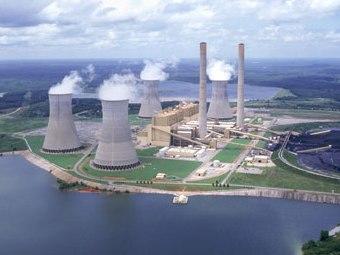
Caption
Plant Scherer in Juliette is one of the plants where Georgia Power plans to leave coal ash waste in unlined pits, where it sits in groundwater.
Credit: File photo

Plant Scherer in Juliette is one of the plants where Georgia Power plans to leave coal ash waste in unlined pits, where it sits in groundwater.
State regulators are set to vote next week on Georgia Power’s long-term plan that environmental and clean energy advocates say doesn’t go far enough to expand solar and other renewable energy and falls short of responsibly closing coal-fired power plants.
A Public Service Commission committee meeting on Thursday was the final hearing to consider the state’s largest utility company’s 2022 Integrated Resource Plan that lays out a vision for producing energy and managing infrastructure as Georgia Power transitions from generating electricity by burning coal to cleaner forms energy.
Robert Jackson, a Sierra Club of Georgia attorney, pushed for regulators to revise Georgia Power’s three-year plan to allocate more capacity for solar power, to support electric vehicles infrastructure, and to ensure the cleanup plan for its toxic coal ash ponds abide by environmental regulations.
Georgia Power officials are projecting over the long term it could take $9 billion to close 12 coal fired-generators by 2028 and retire the last remaining units at Plant Bowen by 2035. The company is also proposing to redistribute coal ash from 19 ponds at landfills, another ash pond or recycle it.
The 10 other ash ponds would be sealed through a “cap in place” process that detractors say poses the threat of toxic chemicals contaminating soil and water.
“(That) leave coal ash sitting in groundwater, the cap in place plans described in the company’s environmental compliance, are illegal under federal and state law,” Jackson said about closures at several sites.
Georgia Power is awaiting word on its permit applications to wind down its aging plants from the state Environmental Protection Division, and has defended its methods for storing coal ash as safe and legal.
Georgia Power Attorney Brandon Marzo said Thursday that the company remains committed to phasing out its remaining coal-fired plants over the next decade, even after a June U.S. Supreme Court ruling that limited the power of the Environmental Protection Agency to set overarching carbon emission regulations at legacy electricity generators.
Among the plans are for units at Plant Wansley in Carroll County to close by Aug. 31. One of the country’s dirtiest and largest coal-fired power generators, Plant Scherer near Macon is also due to be shut down.
The court ruling “does not alter the company’s analysis in this case or the economic conclusion that several of the company’s coal plants are no longer economically viable,” Marzo said.
The PSC is set to vote Thursday on the Georgia Power IRP that sets the course of the next 20 years. The plan is updated every three years, putting it on the same calendar as the company’s rate case, which includes the utility’s request for a 12% rate hike on the typical residential household’s bill over the next three years.
Marzo said that Georgia Power is satisfied that the the latest version of its energy roadmap would provide its 2.7 million customers with clean, safe and reliable electricity for decades.
But environmental and solar industry groups urged regulators to making strides with solar energy by removing a capped limit on the number of customers and megawatts that can be generated on a monthly basis through a Georgia Power program.
Last year, 40,000 customers in Florida signed up for its solar program, eight times what’s allowed in Georgia Power’s net metering program designed to lower customer’s bills based on their excess solar generation.
Georgia Power is awaiting results from a study of its solar net metering that is now capped at 5,000 customers.
Marzo said the analysis should be completed in September 2023 and will likely bolster Georgia Power’s contention that non-solar customers are absorbing too large a share of costs to subsidize users of the clean energy technology.
Commissioner Tim Echols, who uses solar to power his home, opened the door for a last-minute addition that would ramp up solar rooftop opportunities, while pointing out that Georgia Power has consistently resisted progress in solar since 2013.
Marzo said that the plan for the next three years is to bring the utility company closer to the target of doubling its renewable generation to 6,000 megawatts by 2035.
Marzo said that the company’s plan for reinforces the transmission and distribution improvements that are necessary to meet the shift in energy production. Georgia Power is pushing to have 7.8 gigawatts of renewable energy online by 2029 as part of a $12 billion investment.
“Intervenors who’ve requested nearly double the amount of renewables, did not provide sufficient evidence to support their request, nor can they draw a pathway to develop the transmission to get to those higher numbers,” Marzo said.
This story comes to GPB through a reporting partnership with Georgia Recorder.